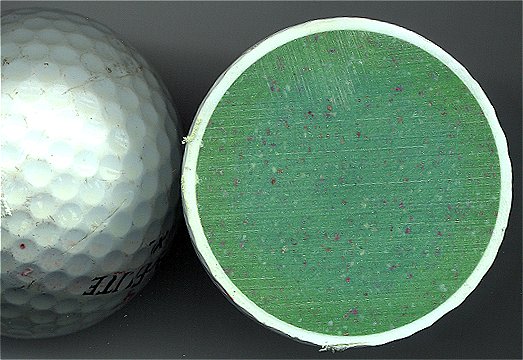Bounding Billies
Today, our guest, operations researcher Andrew Boyd, tells about the simplest of toys, the golf ball. The University of Houston presents this series about the machines that make our civilization run, and the people whose ingenuity created them.
When Coburn Haskell filed his patent in 1898, the golf ball already boasted a long history. For over four hundred years, artisans had crafted a ball known as the featherie, a hollow sack of leather stuffed with boiled goose feathers. Featherie fabrication came to an abrupt halt when in 1845 Robert Paterson fashioned a ball from the sap of trees found in Malaysia.
Known as gutties, they quickly supplanted featheries because they were so much less expensive than their forebears. And if one happened to fly apart in cold weather, a golfer could easily gather the pieces, boil them, and form them once again into a perfectly good golf ball.
Haskell conceived his idea while he visited his playing partner Bertrand Work, then manager of a Goodrich plant in Akron, Ohio. Though solid rubber is too soft to form a good golf ball, it can be stretched until it reaches a suitable degree of firmness, and herein lay Haskell's insight. Pulling threads of rubber taut and winding them upon themselves yields a superior ball.
Of course, wound rubber has a bad tendency to fly about uncontrollably when let loose, and stories of Haskell's first creative efforts are part of golfing folklore. But Haskell persevered, and with the help of Goodrich engineers early refinements such as an incompressible core about which to wind the threads, a balata cover, and better production techniques, the rudiments of the wound ball were well established within a year of its conception.
Haskell's so-called bounding billies were met with considerable resistance by traditionalists as the market-savvy American promoted his invention. But there's no stopping progress, and the wound ball improved upon the quality most sought after by golfers -- distance. The billies were such a success they spawned a burst of creative activity, including patent applications for balls made of steel and springs. Balls filled with compressed gas enjoyed limited commercial success until unwanted explosions proved their undoing.
Remarkable is the fact that the wound ball remained the choice for touring golf professionals for over a hundred years. Despite phenomenal advances in synthetic materials throughout the twentieth century, competing ball designs with one or more solid layers were adopted by only a handful of professionals well into the 1990s.
As late as the year 2000, over seventy percent of the balls teed up at the U.S. Open were still of wound construction. When in that same year Tiger Woods used a solid-construction ball and won the Open by a record-setting fifteen strokes, the days of Haskell's balls were numbered. Now, in 2002, it's hard to even locate a wound ball.
Time marches on, and with it the inevitable progress of our toys. Still, one can only marvel at the longevity of such a simple yet inspired idea as winding rubber thread to form a golf ball.
I'm Andrew Boyd, at the University of Houston, where we're interested in the way inventive minds work.
(Theme music)
An updated version of this episode can be found at 3058.
John F. Hotchkiss, 500 Years of Golf Balls, Dubuque, Iowa: Antique Trader Books, 1997.
"The Solid Truth," vol. 1. A publication of Precept Golf.
Dr. Andrew Boyd is Chief Scientist and Senior Vice President at PROS, a worldwide provider of pricing and revenue optimization solutions. Working with leading academicians and practitioners, he directs an international group of advanced-degree recipients in Economics, Operations Research, Quantitative Marketing, and Statistics. Dr. Boyd received his A.B. with Honors at Oberlin College with majors in Mathematics and Economics in 1981, and his Ph.D. in Operations Research from MIT in 1987. Prior to joining PROS, he enjoyed a successful ten-year career as a university professor, and he is presently an adjunct professor at the University of Houston.

Since Haskell's wound balls centers were finally replaced with new elastic materials, the inside of a modern ball has become pretty uninteresting.